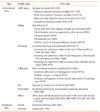In the cause-of-death statistics from 2016 in the Republic of Korea, injury deaths, including those caused by transport accidents, falls, unintentional drowning, intentional self-harm, and homicide, comprised 2.2%, 25.1%, and 55.0% of deaths in the age groups of 0, 1–9, and 10–19 years, in which the number of deaths was 1,707, 1,043, and 1,462, respectively [
1]. In Korea, an analysis was conducted of unintentional injuries in people aged less than 20 years through data of the National Emergency Department Information System of Korea from January 2010 to December 2011, which reported that “Most (94.1%) injuries were unintentional while 5.9% were intentional. The mortality rate was 5.4 per 100,000. The mortality rate of pediatric unintentional injuries was 0.1% including the prehospital deaths and emergency department deaths” [
2]. In another study, 17,105 injured children younger than 15 years of age who visited the emergency room of a single hospital in Korea from June 2011 to May 2013 were analyzed. Among severely-injured patients, the most common place of injury was roads (50.00%, P=0.009), and the most common mechanism of injury was traffic accidents (50.00%), followed by falls (31.82%) (P=0.011) [
3]. In 2004, the injury death rate in children younger than 15 years of age was 10.8 per 100,0000 (639 boys and 393 girls). The most frequent cause was transport accidents (38.0%), followed by drowning (21.2%), falling (13.7%), suffocation (13.3%), burning (6.3%), and poisoning (3.2%). The most common cause was suffocation in infants (less than 1-year-old), falling in 2-year-olds, drowning in 3-year-olds, and transport accidents in 1- and 4-year-olds [
4]. Beyond the above data, few studies have investigated child injury deaths in Korea. Most child injury deaths are preventable by taking appropriate measures and implementing suitable safety systems in the environment. For example, to prevent accidents at home, the dissemination of a manual or booklet entitled the “New parent information kit” is recommended. To prevent bicycle accidents, the need to wear a helmet and to use a coaster brakes should be emphasized, and parents and children should be educated on this topic [
5].
Child injury is one of the most important public health issues in the world [
6]. Unintentional accidents are the most common cause of child deaths worldwide [
7]. Although there was a decrease in child injury deaths after 2003, when the Korean Government initiated a nation-wide child safety system, we should strive further to reduce child injury deaths to provide a safer life for children.
Basic data on child injury deaths are mandatory in order to develop and implement prevention preventable measures or policies. Therefore, we analyzed child injury deaths using micro-data from the death statistics of Korea from 2006 to 2016, which were made available by Statistics Korea.











 PDF
PDF ePub
ePub Citation
Citation Print
Print






 XML Download
XML Download